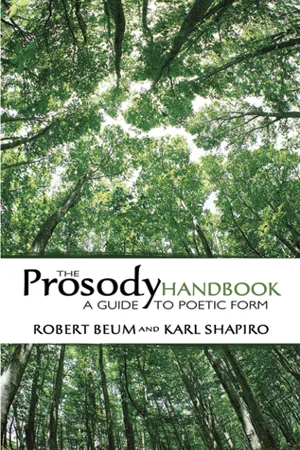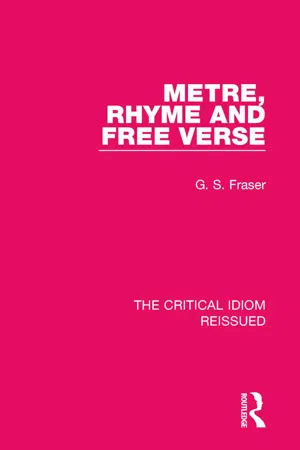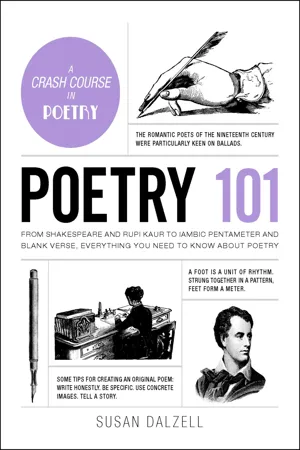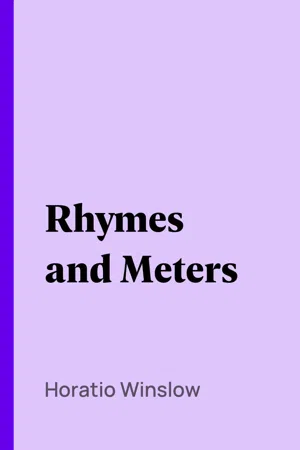Literature
Tercet
A tercet is a stanza in poetry that consists of three lines. It is a common form in various poetic traditions and can be found in works ranging from sonnets to haikus. Tercets are often used to create a sense of rhythm and structure within a poem, and they can also be employed to convey a specific idea or theme.
Written by Perlego with AI-assistance
6 Key excerpts on "Tercet"
- eBook - ePub
The Prosody Handbook
A Guide to Poetic Form
- Robert Beum, Karl Shapiro, Karl Shapiro(Authors)
- 2012(Publication Date)
- Dover Publications(Publisher)
II. TercetSThree lines rhyming consecutively, or three-line stanzas of interlocking rhyme, are called TercetS. When the three lines rhyme consecutively, the stanza is traditionally called a TRIPLET; in the other case terza rima. An unrhymed stanza of three lines (rare) is called a TRISTICH.Terza rima Thou who didst waken from his summer-dreams The blue Mediterranean, where he lay, Lull’d by the coil of his crystalline streams, Beside a pumice isle in Baiae’s bay, And saw in sleep old palaces and towers Quivering within the wave’s intenser day. Triplet Such sharpness shows the sweetest friend, Such cuttings rather heal than rend, And such beginnings touch their end.Tercets are most frequent in the form of terza rima, which was introduced into English poetry, from the Italian, by Sir Thomas Wyatt early in the sixteenth century. Dante’s Divine Comedy (La Divina Commedia) is the world’s most famous terza rima poem. Since the rhyme scheme is fulfilled only as one moves from stanza to stanza, it pulls the attention, by pulling the ear, continuously forward. And because of this strong sense of forward movement, terza rima is equally well suited to narration or to description that seeks to create a unified or dominant impression.Triplets are relatively rare in English, and there are no first-rate triplet poems of any considerable length. It is difficult to find sufficient rhyme, and difficult to endure such intense rhyming for more than a few stanzas. The Augustan poets sometimes allowed triplets in their heroic couplet poems, especially when an effect of expansion or intensification was desired. Robert Bridges’ octosyllabic couplet poem “Eros” ends with a triplet that is strikingly effective by contrast.EXAMPLESterza rima SHELLEY, Ode to the West Wind; BROWNING, The Statue and the Bust triplets GEORGE HERBERT, Paradise; ROBERT HERRICK, Upon Julia’s Clothes III. QUATRAINS
The favorite English verse form is the quatrain, a stanza of four lines. Eight types of quatrains are fairly common: (1) the ballad stanza, (2) the long ballad, (3) the short ballad, (4) the heroic quatrain, (5) the Rubaiyat stanza, (6) the In Memoriam - eBook - ePub
- Jeffrey Wainwright(Author)
- 2015(Publication Date)
- Routledge(Publisher)
John Donne (?1571–1631) uses in his verse letters where he wants a comparatively informal, jocular tone. This is one of those ‘are you still alive, why haven’t you written’ openings, ‘To Mr T.W.’:Pregnant again with th’ old twins hope and fear, Oft have I asked for thee, both how and where Thou wert, and what my hopes of letters were[.]But before we think the triplet an essentially cheery form we should look at Thomas Hardy ’s (1840–1928) adaptation of it in his ‘The Convergence of the Twain (Lines on the loss of the Titanic )’. Here, in the third stanza, he evokes the sunken liner on the ocean floor:Over the mirrors meant To glass the opulent The sea-worm crawls – grotesque, slimed, dumb, indifferent.There is no skip to these lines. There’s symmetry in the monorhyme and in the double length of line 3, but there is a sombre awkwardness to the rhythm. That long third line especially just seems to stare at us unblinkingly.Tercet is a more general term for the three-line stanza which might include other rhyme-patterns such as terza rima , but, particularly in the twentieth century, the grouping need not be rhymed. Wallace Stevens (1879–1955) came to use the form extensively. As this quotation shows however, his Tercets are often not self-contained units. The passages, like this from ‘Notes Toward a Supreme Fiction: It Must Give Pleasure, V’, frequently stretch themselves across the stanza divisions:The elephant Breaches the darkness of Ceylon with blares,The glitter-goes on surfaces of tanks, Shattering velvetest far-away. The bear, The ponderous cinammon, snarls in his mountain - eBook - ePub
- G. S. Fraser(Author)
- 2017(Publication Date)
- Routledge(Publisher)
It has been the aim of this book, as I have said already, to be suggestive rather than exhaustive, and to provide a rationale rather than a dictionary. Most books on metre have a chapter trying to take in at least a good range of English stanza forms, but it is my feeling that, whereas the scanning of a line of verse is always a tricky and difficult business in English, any fool, using the abab formula, can, confronted with a Shakespearian or a Petrarchan sonnet, quatrains, ottava rima stanzas, Spenserian stanzas, villanelles, terza rima, and so on, count rhyme endings, including repeated refrain endings, and make up his own mind about the aesthetic effects of the almost indefinitely various possibilities of English stanzaic formation. But a few very general and very dogmatic remarks may be of use. I think most of the stanzas and individual verse forms (like the sonnet) are made out of combinations of the two rhymed forms that seem most natural in English – the quatrain (abab) and the couplet (aa). Forms based on three-line units, like Italian terza rima or simplified variations of it, seem more difficult to handle in English. Shakespeare’s sonnets, which are probably the greatest sonnets in the English language, consist in fact of three quatrains, abab, cdcd, efef, followed by a clinching couplet, gg. I find myself, and I think this is a common experience of lovers of poetry, that I have many of the first quatrains of Shakespeare’s sonnets by heart, but not the second or the third quatrains, and that, re-reading the sonnets, I often find the clinching couplet trite and disappointing. The proper Italian sonnet rhymes abbaabba, with only two rhymes in the octave (or eight-line first part) and with a variation of two or three other rhymes in the sestet (six-line part), arranged variously, but never so that the last two lines rhyme unless they rhyme with the first line of the sestet. There should be a break in sense between the octave and the sestet, though Milton, one of our greatest sonnet writers, did not always observe this. But Milton’s and Wordsworth’s sonnets have more formal complex unity than Shakespeare’s and if one has any part of them by heart, one probably has them by heart as wholes. The octave tends to have an asserting and advancing, the sestet a receding and conceding movement, rather like wave motions on the shore. Hopkins is the fourth notable English sonnet writer whom one would mention, but one feels that his sonnets are often great poems rather than great sonnets.If we take the quatrain and the couplet as the two primary English stanza forms, the aesthetic quality of the couplet is clinchingness, a tightness, rightness, and condensation,Thy hand, great Anarch, lets the curtain fall: And universal darkness buries all.The quality of the quatrain, as Dr Johnson noted, though not precisely in these words, is a certain spaciousness and grandeur:Full many a gem of purest ray serene The dark unfathomed caves of ocean bear: Full many a flower is born to blush unseen And waste its sweetness on the desert air.Most longer stanzas, as I have said, are combinations of these, or are sometimes, like the stanzas of most of Keats’s odes, cut down from the sonnet (the first quatrain of the sonnet, plus the sestet: in Ode to a Nightingale, the second last line is shortened; in To Autumn - eBook - ePub
Poetry 101
From Shakespeare and Rupi Kaur to Iambic Pentameter and Blank Verse, Everything You Need to Know about Poetry
- Susan Dalzell(Author)
- 2018(Publication Date)
- Adams Media(Publisher)
STANZA, METER, AND FORM The Scaffolding Holding Poems TogetherQuite often, the beauty in a poem is the result of careful scaffolding put in place by the poet. The thoughts may be original, but most poets use tried-and-true poetry tools and techniques to create a compelling poem. A skilled poet takes a familiar form, say a sonnet, and transforms it into a breathtakingly original piece of art. Even Modern poetry uses many hidden and not-so-hidden poetic devices to cast a spell on readers.STANZAStanzas are to poetry what paragraphs are to prose. Essentially, a stanza is a grouping of lines. Typically, a poem is composed of multiple stanzas. They might all have the same number of lines, but that won’t necessarily be the case.Common Stanza TypesCouplet: Two lines of verse grouped together, usually rhyming.Terza rima: Three lines of verse grouped together, with an interlocking rhyme pattern of aba, bcb, cdc, ded , and so forth. The poem concludes with a two-line stanza that rhymes with the middle line of the second-to-last stanza. It’s an Italian form first used in English by Geoffrey Chaucer.Quatrains: Four lines of verse grouped together. The rhyme pattern can vary, but often follows a pattern of aaaa, aabb, abab . Sometimes quatrain refers to a poem with only four lines.Cinquains: (pronounced sing-KEYN ) Five lines of verse grouped together. Rhyme patterns vary.Adelaide CrapseyAdelaide Crapsey (1878–1914) is an American poet credited with inventing the cinquain poem, a twenty-two syllable, five-line poem. She died of tuberculosis in 1914 when she was only thirty-six years old. Her first book of poetry, Verse , was published a year later and included twenty-eight cinquains. Verse sold very well in the 1920s and 1930s and again later in the century and inspired many other poets, including Carl Sandburg.METER, RHYTHM, AND FEETMeter and rhythm, rhythm and meter—the two are intricately linked in poetry. Think of it this way: rhythm is the stressed and unstressed syllables that happen when we speak and meter is the pattern created by those syllables. Let’s break it down one more level: a foot is a unit of rhythm. String the feet together in a pattern and you form a meter. - eBook - ePub
Rhymes and Meters
A Practical Manual for Versifiers
- Horatio Winslow(Author)
- 2009(Publication Date)
- Perlego(Publisher)
The sestina has six six-line stanzas and an envoy: in the stanzas the final words of each line remain the same throughout, though the order is changed. In the three-line envoy the six words must appear again and in an established order. The sestina is a trifle too long to quote, but one of the best and sanest examples is to be found in Kipling’s Seven Seas—“The Sestina of the Tramp Royal.” Swinburne’s sestinas though “poetic” are very cloudy in meaning.The pantoum, another involved arrangement, is made up of four-line stanzas in which the second and fourth lines of the first verse are used as the first and third lines of the second verse, and so on ad infinitum until the weary author ends by repeating the first and third lines of the whole production as the second from the last and the last of the concluding stanza.There is great good for the beginner in writing these French forms even if he takes up the work only as an exercise. Their construction is so certain and fixed that an error is glaring. Though it may be brow-wrinkling to build a ballade, it is a simple matter to see its faults.There is also value in these forms for the advanced student. They embody suggestions for new stanza forms and fresh verse in general. The use of the ballade variant may be found in Kipling. When varied the triolet may give exactly the right ring for some idea which refuses to fit itself into the conventional molds. When one has served his apprenticeship he may arrange and rearrange as he sees fit, bending the stanza to his purpose. Of the forms he is not the slave but the master.VIII
THE SONG
CHAPTER VIII
THE SONG
A variety of verse which has great vogue now and which has so developed as to be considered almost as individual as the rondeau or sonnet is the modern “song.”Formerly the “song” was written to music or at least written that it might be set to music, but now it must sing itself. It may dress in sober iambics if it pleases, but there must be a lilt and go to the words to suggest music. Among the best examples of this form open to the reader are the songs of Robert Burns. Though written to fit old Scotch airs the words themselves suggest a melody to any one with the slightest ear for music. For instance: - Available until 31 Dec |Learn more
The Book of Forms
A Handbook of Poetics, Fifth Edition
- Lewis Turco(Author)
- 2020(Publication Date)
- UNM Press(Publisher)
tristrophic (thrime ), and so on through the standard prefixes . Often lines of the same length in a stanza will be indented the same number of spaces or will begin at the margin ; similarly, the poet may indent or not indent lines according to the rhyme scheme . Another convention capitalizes the initial letters of a poem, and sometimes these initials will form an acrostic . Longer divisions of poems are cantos, fits , and movements . A coda (cauda, tail) is a concluding demistrophe (partial stanza) that appears in certain forms such as the French sestina and the ballade , often as an envoi (envoy) . Poems that are not broken into stanzaic or strophic divisions are called astrophic .The sonic level of the poem is as important as the typographical.A prosody based upon the typographical level —what poems look like on the page—is called spatial prosody . An ordinary poem—that is, a poem written in prose or verse, but in shaped stanzas , is variously called carmen figuratum or hieroglyphic verse, pattern verse or the calligramme; a concrete poem is an ideograph , a figure that represents something else, but without naming it, like a character in the Chinese language, whose impact is almost wholly visual; for instance, in English the ideograph & (an ampersand) may be pronounced “and,” “besides,” or “also” as in, “We went to the party & found many others there, including Bob and Fred; & Jane—& Bill and Nancy off in a corner somewhere.” The typewriter poem is one that does not necessarily make sense except for the picture it makes out of letters of the alphabet. Spatial verse may utilize positive or negative shaping ; the former utilizes words to make the shape, and the latter utilizes words to surround the shape. For an elaborate example, see the sampler
Index pages curate the most relevant extracts from our library of academic textbooks. They’ve been created using an in-house natural language model (NLM), each adding context and meaning to key research topics.





